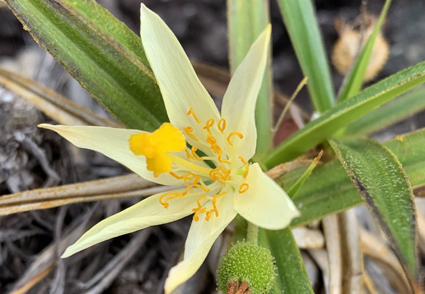Abstract
Two new narrowly distributed species of Vellozia (Velloziaceae) are described, illustrated, and a preliminary status of conservation was assessed, Vellozia flavida Mello-Silva ex Magri and V. formosa Mello-Silva ex Magri. Both species occur in the municipality of Monte Azul, Minas Gerais State, Brazil, in the Campos Rupestres vegetation. Vellozia flavida is closely related to V. luteola and both are easily recognized by having yellow perianth, an uncommon character in the genus. Vellozia flavida however is distinguished by the high number of stamens (22) and the presence of capitate hypanthial emergences, whereas V. luteola has 15 stamens and subulate hypanthial emergences. Vellozia formosa is morphologically related to V. nanuzae, showing similar habits, however, it is distinguished by the leaf blades covered with long emergences on both surfaces vs. glabrous in V. nanuzae. Due to the narrow distribution of V. flavida and V. formosa and threats to their habitat such as mining and livestock industries, they were considered as critically endangered (CR) according to IUCN criteria.
References
- Bachman, S., Moat, J., Hill, A., de la Torre, J. & Scott, B. (2011) Supporting Red List threat assessments with GeoCAT: Geospatial Conservation Assessment Tool ZooKeys 150: 117–126. https://doi.org/10.3897/zookeys.150.2109
- Cabral, A., Magri, R.A. & Lopes, J.C. (2022) Increasing knowledge on the diversity of canelas-de-ema in the campo rupestre: two new species of Vellozia (Velloziaceae) from the southern Espinhaço Range, Brazil. Plant Ecology and Evolution 155: 323–352. https://doi.org/10.5091/plecevo.94326
- Cabral, A., Ferreira-Júnior, C.A. & de Menezes, N.L. (2023) Two new remarkable species of Barbacenia (Velloziaceae) from the Brazilian Espinhaço Range in honor of Renato Mello-Silva. Phytotaxa 616 (3): 279–287. https://doi.org/10.11646/phytotaxa.616.3.7
- Cardoso, P.H., Moroni, P., Antar, G.M., Neto, L.M. & Trovó, M. (2022) Two new Brazilian species of Verbenaceae from the Espinhaço Range: Stachytarpheta olearyana and S. vianae. Kew Bulletin 77: 729–736. https://doi.org/10.1007/s12225-022-10045-0
- Colli‐Silva, M., Vasconcelos, T.N.C. & Pirani, J.R. (2019) Outstanding plant endemism levels strongly support the recognition of campo rupestre provinces in mountaintops of eastern South America. Journal of Biogeography 46: 1723–1733. https://doi.org/10.1111/jbi.13585
- Conceição, A.A., Rapini, A., do Carmo, F.F., Brito, J.C., Silva, G.A., Neves, S.P. & Jacobi, C.M. (2016) Rupestrian grassland vegetation, diversity, and origin. In: Fernandes, G. (Ed.) Ecology and conservation of mountaintop grasslands in Brazil. Springer Cham. pp. 105–127. https://doi.org/10.1007/978-3-319-29808-5_6
- Flora e Funga do Brasil (2024) Velloziaceae. Jardim Botânico do Rio de Janeiro. Available at: https://floradobrasil.jbrj.gov.br/FB245 (accessed 30 May 2024)
- Giulietti, A.M., Pirani, J.R. & Harley, R.M. (1997) Espinhaço Range region. In: Davis, S.D., Heywood, V.H., Macbryde, O.H., Villa-Lobos, J. & Hamilton, A.C. (Eds.) Centers of plant diversity: A guide and strategy for their conservation. Vol. 3 . IUCN Publication Unity. Cambridge. pp. 397–404.
- Gonçalves, E.G. & Lorenzi, H. (2011) Morfologia Vegetal. Vol. 2. Instituto Plantarum, Nova Odessa.
- Jussieu, A.L. (1789) Genera plantarum secundum ordines naturales disposita juxta methodum in horto regio parisiensi exaratam, anno 1774. Hérissant & Th. Barrois, Paris. https://doi.org/10.5962/bhl.title.284
- IUCN Standards and Petitions Committee (2019) Guidelines for Using the IUCN Red List Categories and Criteria. Version 14. Prepared by the Standards and Petitions Subcommittee, IUCN, Gland. Available from: http://www.iucnredlist.org/documents/RedListGuidelines.pdf (accessed 22 February 2024)
- Kao, P.C. (1980) A new genus of Amaryllidaceae from China. Vol. 1. Chengdu Institute of BioIogy. Academia Sinica, pp. 1–3.
- Mello-Silva, R. (2005) Morphological analysis, phylogenies and classification in Velloziaceae. Botanical Journal of the Linnean Society 148: 157–173. https://doi.org/10.1111/j.1095-8339.2005.00399.x
- Mello-Silva, R. & Menezes, N.L. (1988) Duas espécies novas de Velloziaceae de Minas Gerais. Acta Botanica Brasilica 1: 195–207. https://doi.org/10.1590/S0102-33061987000300019
- Mello-Silva, R. & Menezes, N.L. (1999) Two new Brazilian Velloziaceae, Vellozia auriculata and Vellozia gigantea, and a key to the related dracenoid species of Vellozia. Novon 9 (4): 536–541. https://doi.org/10.2307/3392159
- Mello-Silva, R. & Menezes, N.L. (2014) Velloziaceae in honorem appellatae. Phytotaxa 175: 85–96. https://doi.org/10.11646/phytotaxa.175.2.3
- Mello-Silva, R., Santos, D.Y.A.C., Salatino, M.L.F., Motta, L.B., Cattai, M.B., Sasaki, D., Lovo, J., Pita, P.B., Rocini, C., Rodrigues, C.D.N., Zarrei, M. & Chase, M.W. (2011) Five vicariant genera from Gondwana: the Velloziaceae as shown by molecules and morphology. Annals of Botany 108: 87–102. https://doi.org/10.1093/aob/mcr107
- Pirani, J.R., Mello-Silva, R. & Giulietti, A.M. (2003) Flora de Grão-Mogol, Minas Gerais, Brasil. Boletim de Botânica da Universidade de São Paulo 21: 1–24. https://doi.org/10.11606/issn.2316-9052.v21i1p1-24
- Pohl, J.E. (1828) Plantarum brasiliae icones et descriptiones hactenus ineditae: Iussu et auspiciis Francisci Primi, imperatoris et regis augustissimi. Vol. 1. Vindobonae, Wien. https://doi.org/10.5962/bhl.title.451
- QGIS.org (2024) QGIS Geographic Information System. Open Source Geospatial Foundation Project. Available from: http://qgis.org (accessed 30 May 2024)
- da Silva, D.N., Antonicelli, M.C.A. & Guimarães, P.J.F. (2023) Taxonomic Novelties from the Espinhaço Septentrional: Two New Species of Pleroma and the First Records of Melastomataceae from the Morro das Marombas, Minas Gerais, Brazil. Systematic Botany 48: 44–54. https://doi.org/10.1600/036364423X16758873924090
- Silveira, F.A.O., Negreiros, D., Barbosa, N.P.U., Buisson, E., Carmo, F.F., Carstensen, D.W., Conceição, A.A., Cornelissen, T.G., Echternacht, L., Fernandes, G.W., Garcia, Q.S., Guerra, T.J., Jacobi, C.M., Lemos-Filho, J.P., Le Stradic, S., Morellato, L.P.C., Neves, F.S., Oliveira, R.S., Schaefer, C.E., Viana, P.L. & Lambers, H. (2016) Ecology and evolution of plant diversity in the endangered campo rupestre: a neglected conservation priority. Plant and soil 403: 129–152. https://doi.org/10.1007/s11104-015-2637-8
- Smith, L.B. (1962) A synopsis of the American Velloziaceae. Contributions from the United States National Herbarium 35: 251–292.
- Smith, L.B. & Ayensu, E.S. (1976) A revision of American Velloziaceae. Smithsonian Contributions to Botany 30: 1–172. https://doi.org/10.5479/si.0081024X.30
- Thiers, B.M. (2024) [updated continuously] Index Herbariorum. Available at: https://sweetgum.nybg.org/science/ih/ (accessed 30 May 2024)
- Vandelli, D. (1788) Florae lusitanicae et brasiliensis specimen. Typographica Academico-Regia, Coimbra.
- Zavatin, D.A., Almeida, R.B.P., Ramos, R. & Lombardi, J.A. (2023) Chionanthus monteazulensis (Oleaceae), a new species from the campo rupestre of Espinhaço Range, Brazil. Phytotaxa 603: 289–296. https://doi.org/10.11646/phytotaxa.603.3.8


